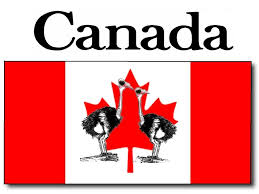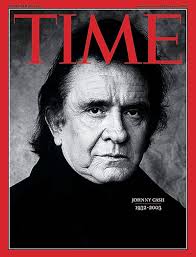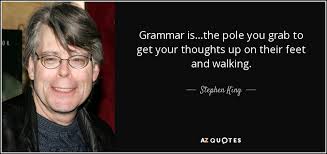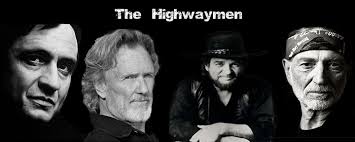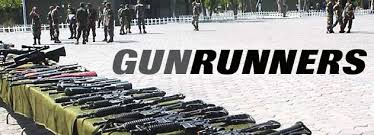 International trafficking in small arms and light weapons—gunrunning—is a major world business, both in legal and black markets. It’s estimated nearly two billion firearms have circulated the planet with millions more produced each year. There’s millions of gun-related deaths and no end in sight for reduction. But it’s not the guns, or the people, that kill. It’s something else—something unchecked that drives huge profits in the global gunrunning trade.
International trafficking in small arms and light weapons—gunrunning—is a major world business, both in legal and black markets. It’s estimated nearly two billion firearms have circulated the planet with millions more produced each year. There’s millions of gun-related deaths and no end in sight for reduction. But it’s not the guns, or the people, that kill. It’s something else—something unchecked that drives huge profits in the global gunrunning trade.
First, let’s look at the definition of small arms / light weapons. This comes right from the International Tracing Instrument (ITI) adopted by the United Nations General Assembly.
 “Small Arms are, broadly speaking, weapons designed for individual use. They include, inter alia, revolvers and self-loading pistols, rifles and carbines, sub-machine guns, assault rifles and light machine guns; any man-portable lethal weapon that expels or launches, is designed to expel or launch, or may be readily converted to expel or launch a shot, bullet or projectile by the action of an explosive, excluding antique small arms and light weapons or their replicas. Antique small arms and light weapons and their replicas will be defined in accordance with domestic law. In no case will antique small arms and light weapons include those manufactured after 1899.”
“Small Arms are, broadly speaking, weapons designed for individual use. They include, inter alia, revolvers and self-loading pistols, rifles and carbines, sub-machine guns, assault rifles and light machine guns; any man-portable lethal weapon that expels or launches, is designed to expel or launch, or may be readily converted to expel or launch a shot, bullet or projectile by the action of an explosive, excluding antique small arms and light weapons or their replicas. Antique small arms and light weapons and their replicas will be defined in accordance with domestic law. In no case will antique small arms and light weapons include those manufactured after 1899.”
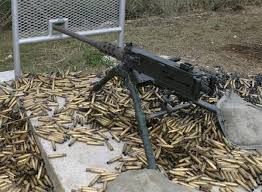 “Light Weapons are, broadly speaking, weapons designed for use by two or three persons serving as a crew, although some may be carried and used by a single person. They include, inter alia, general purpose or universal machine guns, medium machine guns, heavy machine guns, rifle grenades, under-barrel grenade launchers and mounted grenade launchers, portable anti-aircraft guns, portable anti-tank guns, recoilless rifles, man portable launchers of anti-tank missile and rocket systems, man portable launchers of anti-aircraft missile systems, and mortars of a calibre of less than 100 millimetres.”
“Light Weapons are, broadly speaking, weapons designed for use by two or three persons serving as a crew, although some may be carried and used by a single person. They include, inter alia, general purpose or universal machine guns, medium machine guns, heavy machine guns, rifle grenades, under-barrel grenade launchers and mounted grenade launchers, portable anti-aircraft guns, portable anti-tank guns, recoilless rifles, man portable launchers of anti-tank missile and rocket systems, man portable launchers of anti-aircraft missile systems, and mortars of a calibre of less than 100 millimetres.”
Notice something left off the list? I’ll get to that. Let’s look at some big-time gunrunners, current and past.
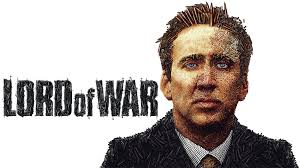 You’ve probably heard of the Nicolas Cage movie Lord Of War where he portrays a bad-ass based on the real character—Russian arms-trafficker Viktor Bout. From what I’ve seen and heard about the industry, it’s probably not far off the mark.
You’ve probably heard of the Nicolas Cage movie Lord Of War where he portrays a bad-ass based on the real character—Russian arms-trafficker Viktor Bout. From what I’ve seen and heard about the industry, it’s probably not far off the mark.
Take Dale Stoffel. He was a hi-rolling American mercenary / arms dealer who smuggled guns in the Middle East under the shadowy wing of a covert US agency. Predictably, he got whacked in Baghdad back in 2004 but his life was something another movie should be made on.
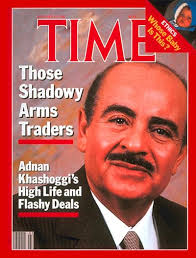 The current king of private arms dealers is Saudi billionaire Adnan Khashoggi who operates out of Monaco. He got his start supplying weapons to no other than David Stirling, the father of the British SAS, who was doing some stuff in the Middle East. Khashoggi was part of the Iran-Contra gunrunning scandal that nearly took down Ronald Reagan’s presidency, but squeaked out when Colonel Oliver North took the fall. North was a gunrunner if there ever was one.
The current king of private arms dealers is Saudi billionaire Adnan Khashoggi who operates out of Monaco. He got his start supplying weapons to no other than David Stirling, the father of the British SAS, who was doing some stuff in the Middle East. Khashoggi was part of the Iran-Contra gunrunning scandal that nearly took down Ronald Reagan’s presidency, but squeaked out when Colonel Oliver North took the fall. North was a gunrunner if there ever was one.
It’d be unfair to leave out Monzer al-Kassar. The “Prince of Marbella” is a Syrian who worked from Spain and was also part of the Iran-Contra deal. He went on to get caught by a US DEA sting where al-Kassar was selling weapons to the FARC in Colombia. He’s now doing thirty years in an American pen.
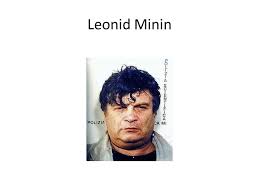 Still operating is Russian Leonid Minin who’s currently busy supplying to the mess in the Ukraine. Some of his previous customers were Charles Taylor of Liberia and a guy by the name of Muammar Gaddafi, a Libyan who’s now dead.
Still operating is Russian Leonid Minin who’s currently busy supplying to the mess in the Ukraine. Some of his previous customers were Charles Taylor of Liberia and a guy by the name of Muammar Gaddafi, a Libyan who’s now dead.
These shady characters are great stuff for movies, but the real big gunrunners in the global small arms trade are legitimate companies operating under legitimate government regulations.
And their commodity’s not handguns. It’s assault rifles… and something else.
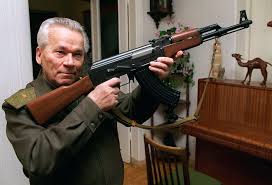 Russia leads the pack with its production and exports of Mikhail Kalashnikov products made famous by the AK47. Close behind is China with the Type 56, a Kalashnikov knock-off. Third is the US with the M16, followed by Heckler & Koch out of Germany with the G3 and the MP5. Belgium is a big producer of FN armaments and, surprisingly, Canada is a major world producer and exporter.
Russia leads the pack with its production and exports of Mikhail Kalashnikov products made famous by the AK47. Close behind is China with the Type 56, a Kalashnikov knock-off. Third is the US with the M16, followed by Heckler & Koch out of Germany with the G3 and the MP5. Belgium is a big producer of FN armaments and, surprisingly, Canada is a major world producer and exporter.
It’s not guns Canada is pumping out, though. It’s worse.
 You have to give credit to agencies like the Small Arms Survey who keep track of these guys. This is a credible watchdog—an independent research project funded by the Graduate Institute of International and Development Studies in Geneva, Switzerland. It puts out an annual report of shocking information and statistics as a resource for governments, policy makers, and activists, as well as researchers on small arms issues.
You have to give credit to agencies like the Small Arms Survey who keep track of these guys. This is a credible watchdog—an independent research project funded by the Graduate Institute of International and Development Studies in Geneva, Switzerland. It puts out an annual report of shocking information and statistics as a resource for governments, policy makers, and activists, as well as researchers on small arms issues.
Here’s what the Small Arms Survey say about themselves.
“The Survey monitors national and international initiatives (governmental and non-governmental), and acts as a forum and clearinghouse for the sharing of information. It also disseminates best practice measures and initiatives dealing with small arms issues.
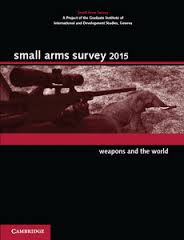 The Small Arms Survey mandate is to look at all aspects of small arms and armed violence. It provides research and analysis by which to support governments to reduce the incidence of armed violence and illicit trafficking through evidence-based analysis.
The Small Arms Survey mandate is to look at all aspects of small arms and armed violence. It provides research and analysis by which to support governments to reduce the incidence of armed violence and illicit trafficking through evidence-based analysis.
The project’s staff includes international experts in security studies, political science, law, international public policy, development studies, economics, conflict resolution, and sociology. The staff works closely with a worldwide network of researchers and partners.
The project’s flagship publication is the Small Arms Survey, an annual review of global small arms issues such as production, stockpiles, brokering, legal and illicit arms transfers, the effects of small arms, and national, bilateral, and multilateral measures to deal with the problems associated with small arms. Published by Cambridge University Press, it is recognized as the principal international source of impartial and reliable information on all aspects of small arms. It is widely used policy-makers, government officials and non-governmental organizations.”
Like I said, this is a credible outfit that publishes an annual report that’s publicly available. And, year after year, they’ve pointed-out a scam in the international assault-rifle business that gunrunners manipulate.
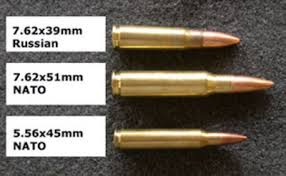 I mentioned the big five assault weapons — the AK47, the Type 56, the M16, the G3 & MP5, and the FN lines. Well, coincidently, there’s also five major types of ammunition these weapons require before they can kill people.
I mentioned the big five assault weapons — the AK47, the Type 56, the M16, the G3 & MP5, and the FN lines. Well, coincidently, there’s also five major types of ammunition these weapons require before they can kill people.
The 7.62 x 54 Russian
The 7.62 x 51 NATO
The 7.62 x 39 Russian
The 5.56 x 45 NATO
The 5.56 x 39 Russian
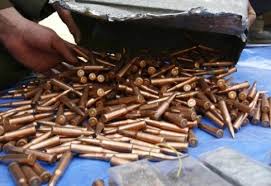 What’s going on is these assault rifles get cross-chambered for different calibers of bullets and selectively distributed to hot spots around the world. The ammunition is then brokered on the side.
What’s going on is these assault rifles get cross-chambered for different calibers of bullets and selectively distributed to hot spots around the world. The ammunition is then brokered on the side.
It’s the old law of supply and demand, folks. Some banana-republic warlord in Sierra Leone buys a batch of AK47’s chambered in 5.56 x 39 and receives cases of 5.56 x 45’s to go with it. Won’t work. So while he’s desperate to get on with the war, in steps a guy like old Minin who sells him the right ammo at grossly inflated prices. And that’s how big money’s made in gunrunning. Short the supply. Supply the demand.
So who’s making the ammunition? The stuff that really kills people?
 Let’s look at something the Canadian Press just dug up. It’s also reported by the CBC. These figures are estimates, based on investigative reporting, so I can’t verify their accuracy. However, I believe they’ve found something nasty.
Let’s look at something the Canadian Press just dug up. It’s also reported by the CBC. These figures are estimates, based on investigative reporting, so I can’t verify their accuracy. However, I believe they’ve found something nasty.
In 2014, the United States imported $995 million worth of small arms—of that $139 million (14%) was in ammunition. The United States exported $606 million—of that $158 million (26%) was in ammo.
In 2014, Canada imported $26 million worth of small arms—of that $2.75 million (11%) was in ammunition. Canada exported $415 million worth of small arms—of that $320 million (77%) was in ammo, including military explosives and detonators.
Notice that ammunition was left off the UN’s list?
It’s not guns that kill people. It’s not people that kill people. It’s bullets that kill people. Guns are useless without bullets.

